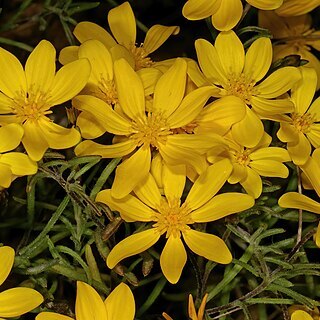Annual herb, 3-15, sometimes up to 25 cm high. Stems and branches erect or ascending, leafy, glabrous or tomentose and with stalked glands. Leaves alternate or sometimes opposite, spreading, slender, mid-ribbed, linear, 5-30 mm long, 0.4-2 mm wide, glandular with stalked glands and sometimes tomentose mainly above, acute-obtuse. Capitula solitary, pedunculate, terminal. Peduncles 2-20 mm long. Involucre urceolate or widely cyathiform, almost orbicular in outline, 2-10 mm wide. Involucral bracts 10-35, outer ovate, inner ovate-oblong with a spreading, brown, scarious apical limb, up to 5.5 mm long, up to 2.5 mm wide, acute-obtuse. Receptacle flat-convex, paleate. Paleae lanceolate, canaliculate and marginally flattened and often projected into two lateral teeth, otherwise entire, 3-5.5 mm long, 0.6-1.3 mm wide, dorsally sometimes sparsely gland-dotted, acute. Ray-florets 4-15. Tube cylindrical, 1.2-2 mm long, with mainly laterally scattered, subulate-triangular hairs. Lamina elliptic, 2-15 mm long, 1-6 mm wide, 4-10-veined. Style 1.8-3.4 mm long; style-branches 0.8-1.5 mm long. Achenes as in disc-florets, but more densely villose. Disc-florets 8-150, perfect. Corolla 2.5-3.8 mm long, 0.4-0.7 mm wide. Tube cylindrical, with scattered, subulate-triangular hairs on upper half. Limb cyathiform; corolla lobes 0.4-0.7 mm long, sometimes with a shortly stalked gland at apex. Style 2.5-3.8 mm long; style-branches 0.4-1.3 mm long, apically penicillate and truncate; stylopodium ± distinct. Anthers 1-2.2 mm long; tails c. 1/5 of the length of the anther. Achenes narrowly elliptic, 1.5-2.5 mm long, 0.3-0.6 mm wide, ± densely villose with erecto-patent, apically hooked hairs; pappus crownlike, of ± connate scales, up to 0.6 mm long.
More
Erect or spreading annual, up to 200 mm tall. Leaves linear, 5-30 mm long, glandular-hairy and sometimes cobwebby above. Flowerheads solitary on short, slender peduncles, radiate, yellow, 10-15(-20) mm diam., receptacle paleate, florets coarsely hairy around middle; involucre broadly urn-shaped to suborbicular.
Spreading, thinly cobwebby annual to 20 cm. Leaves linear, glandular-hairy. Flower heads radiate, solitary on short, slender peduncles, yellow.

